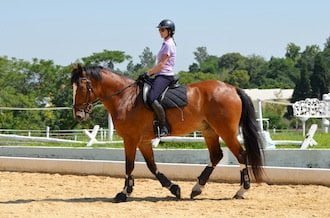
In upcoming issues of HQ, Helmut Wagner, will provide practical tips on how you can make the most of your horse’s best talents. Whether you ride an imported Warmblood or a homegrown crossbreed, you can use the dressage arena to create a healthy, happy athlete.
Far too little emphasis is put on the fact that first and foremost our dressage arena serves as a school of gymnastics for the horse.
The priority of using the school should always be the thorough training of the horse; the rider’s progress takes secondary place. Why? Because a horse who is stiff and unbalanced is no pleasure at all! Only on a horse who is correctly working over the back, is supple and balanced can a pupil learn how to sit well and go with the movement as well as improve his or her feel and understanding of the correct use of the aids.
Effective schooling

Anyone with the privilege of owning and riding a horse cannot be encouraged enough to remember that in every schooling session the horse must be ‘gymnasticised’ and ‘elasticised’ thoroughly on both reins.
There is absolutely no value in going round and round at a snail’s pace or hurrying along like a sewing machine with a horse who invariably starts off with the incorrect bend and position in walk, trot and canter. It is equally unconstructive to force the horse, on entering the school, into the supposedly attractive ‘dressage frame’, before the horse has had a chance to loosen up.
Straightening
There is a particular exercise plan involved in every schooling session of your horse. There should be consistent focus on the straightening of the horse (in order to overcome his ‘natural crookedness’) by encouraging activity on diagonal legs, in other words taking the weight on the right hind and left fore in rising trot, thinking of shoulder-in on the right rein and travers on the left rein and vice versa in order to loosen and supple up the stiff diagonal.
Reviewing the walk

The walk especially should not be neglected in the purposeful loosening and suppling work of the horse, in all three variants: collected, medium and extended walk. Unfortunately this is often overlooked as few riders are capable of executing the various walk paces correctly! Why? Because generally they are not practised systematically. Even on questioning experienced riders on the differences between the walk paces, one usually receives incomplete answers. It is important to know that in the medium walk the horse is required to track up with the hind foot into the print left by the front foot. In the collected walk the horse’s hind foot stays behind the imprint left by the front foot. In the extended walk it is required that the hind foot overtracks (lands in front of the print left by the front foot) as far as possible.
Text: Helmut Wagner
Photography: Charlotte Bastiaanse
The full article appears in the May 2015 issue of HQ. The next part of this series will feature in the June issue.

